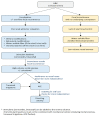State of the Art Bowel Management for Pediatric Colorectal Problems: Spinal Anomalies
- PMID: 37761519
- PMCID: PMC10529947
- DOI: 10.3390/children10091558
State of the Art Bowel Management for Pediatric Colorectal Problems: Spinal Anomalies
Abstract
Background: Patients with spinal abnormalities often struggle with fecal and/or urinary incontinence (up to 87 and 92%, respectively) and require a collaborative approach to bowel management in conjunction.
Methods: To define existing approaches and propose state-of-the-art bowel management, a literature search was performed using Medline/PubMed, Google Scholar, Cochrane, and EMBASE databases and focusing on the manuscripts published July 2013 and July 2023.
Results: Patients with spinal anomalies have impaired innervation of the rectum and anal canal, decreasing the success rate from laxatives and rectal enemas. Thus, transanal irrigations and antegrade flushes are widely utilized in this group of patients. Based on spinal MRI, the potential for bowel control in these children depends on age, type, and lesion level. On referral for bowel management, a contrast study is performed to assess colonic motility and evacuation of stool, followed by a series of abdominal X-rays to define colonic emptying and adjust the regimen. The options for management include laxatives, rectal enemas, transanal irrigations, antegrade flushes, and the creation of a stoma. Approximately 22-71% of patients achieve social continence dependent on the type and level of the lesion.
Conclusion: Patients with spinal anomalies require a thorough assessment for continence potential and stool burden prior to initiation of bowel management. The optimal treatment option is defined according to the patient's age, anatomy, and mobility. The likelihood of independent bowel regimen administration should be discussed with the patients and their caregivers.
Keywords: antegrade continence enema; bowel management; constipation; enema; fecal incontinence; meningocele; spina bifida; spinal anomaly; tethered cord; urinary incontinence.
Conflict of interest statement
The authors declare no conflict of interest.
Figures






Similar articles
-
State of the Art Bowel Management for Pediatric Colorectal Problems: Functional Constipation.Children (Basel). 2023 Jun 19;10(6):1078. doi: 10.3390/children10061078. Children (Basel). 2023. PMID: 37371309 Free PMC article. Review.
-
State of the Art Bowel Management for Pediatric Colorectal Problems: Anorectal Malformations.Children (Basel). 2023 May 8;10(5):846. doi: 10.3390/children10050846. Children (Basel). 2023. PMID: 37238394 Free PMC article. Review.
-
Bowel management in children with spina bifida.J Pediatr Rehabil Med. 2018;11(4):293-301. doi: 10.3233/PRM-170533. Epub 2018 Nov 28. J Pediatr Rehabil Med. 2018. PMID: 30507592 Review.
-
Appendicostomy stomas and antegrade colonic irrigation after laparoscopic antegrade continence enema.J Laparoendosc Adv Surg Tech A. 2006 Aug;16(4):400-3. doi: 10.1089/lap.2006.16.400. J Laparoendosc Adv Surg Tech A. 2006. PMID: 16968193
-
The success rate of antegrade enemas for the management of idiopathic constipation.Pediatr Surg Int. 2022 Dec;38(12):1729-1736. doi: 10.1007/s00383-022-05214-y. Epub 2022 Sep 15. Pediatr Surg Int. 2022. PMID: 36107238
Cited by
-
Is Collaborative Care the Future of Medicine? Lessons Learned from the Care of Children with Colorectal Conditions.Children (Basel). 2024 May 9;11(5):570. doi: 10.3390/children11050570. Children (Basel). 2024. PMID: 38790565 Free PMC article. Review.
References
-
- Parker S.E., Mai C.T., Canfield M.A., Rickard R., Wang Y., Meyer R.E., Anderson P., Mason C.A., Collins J.S., Kirby R.S., et al. National Birth Defects Prevention Network. Updated National Birth Prevalence Estimates for Selected Birth Defects in the United States, 2004-2006. Birth Defects Res. A Clin. Mol. Teratol. 2010;88:1008–1016. doi: 10.1002/bdra.20735. - DOI - PubMed
-
- Wiener J.S., Suson K.D., Castillo J., Routh J.C., Tanaka S., Liu T., Ward E., Thibadeau J., Joseph D. Registry NSBP Bowel Management and Continence in Adults with Spina Bifida: Results from the National Spina Bifida Patient Registry 2009-15. J. Pediatr. Rehabil. Med. 2017;10:335–343. doi: 10.3233/PRM-170466. - DOI - PMC - PubMed
Publication types
LinkOut - more resources
Full Text Sources

